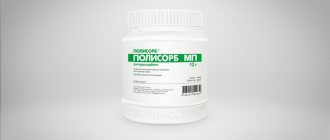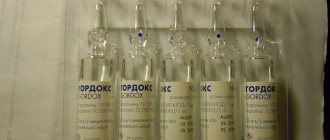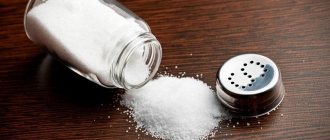Levomycetin is a broad-spectrum antibiotic with a bacteriostatic mechanism of action. It is used primarily for the treatment of intestinal infections that develop as a result of eating stale and poor-quality food. In case of poisoning, chloramphenicol often serves as the main means of etiotropic therapy, it allows you to destroy pathogenic microflora and stop diarrhea.
In the photo, chloramphenicol is the main treatment for intestinal infections
Pharmacological properties of the drug Levomycetin tablets
Pharmacodynamics. Levomycetin is a broad-spectrum antibiotic. It is effective against many gram-positive and gram-negative bacteria (pathogens of purulent infections, typhoid fever, dysentery, meningococcal infections, Haemophilus influenzae, Brucella, etc.), rickettsia, chlamydia, spirochetes, and some large viruses. Acts on bacterial strains resistant to penicillin, streptomycin, and sulfonamides. The drug is inactive against acid-fast bacteria, Pseudomonas aeruginosa, clostridia and protozoa. Disturbs protein synthesis in microbial cells. In therapeutic concentrations it exhibits a bacteriostatic effect. Resistance of microorganisms to the drug develops relatively slowly, and, as a rule, cross-resistance to other chemotherapeutic agents does not occur. Pharmacokinetics . It is well and quickly absorbed after oral administration: the maximum concentration in the blood is reached after 2–3 hours, the therapeutic concentration in the blood serum is maintained for 4–5 hours after administration. Penetrates into organs, tissues and body fluids, passes through the BBB, penetrates well into the CSF (up to 50% of the content in the blood), penetrates the placenta, and is excreted into breast milk. Therapeutic concentrations of the drug when administered orally are determined in the vitreous body, cornea, iris, and aqueous medium of the eye (the drug does not penetrate into the lens). It is excreted mainly in the urine (mainly in the form of inactive metabolites), partially in bile and feces. In the intestine, under the influence of intestinal bacteria, it is hydrolyzed to form inactive metabolites.
Mechanism of development of intestinal infection
Bacteria contained in spoiled foods are the main cause of foodborne illnesses
Over time, food spoils. The process of decomposition begins in them, and bacteria pathogenic for humans begin to multiply. The latter, during their life processes, release toxic substances, which also accumulate in the product.
Toxic and bacterial contamination of food is directly proportional to its storage time. The longer food is stored, the more dangerous it becomes.
The following products are most susceptible to contamination by microorganisms:
- meat;
- fish;
- milk;
- fermented milk mixtures;
- some types of cereals.
Probably every housewife's milk has turned sour
When you eat spoiled food, all the toxins and bacteria accumulated in it enter the intestines. The price of this is inflammation of the mucous membranes, diarrhea, vomiting, purulent impurities in the stool. Bacteria continue to develop in the intestine, which quickly leads to toxic substances entering the blood and the development of general intoxication. Hyperthermia, headaches, chills, aches in the bones and muscles appear.
A distinctive feature of food poisoning is the rapid, sometimes within 30-40 minutes, appearance of the first symptoms of the disease, a clear connection with food intake, and the simultaneous development of intoxication in the entire group of people who consumed the spoiled product.
The average duration of the disease is 3-6 days. Foodborne infection is not transmitted from person to person. The video in this article will tell you more about what food poisoning is and how to treat it.
Use of the drug Levomycetin tablets
Levomycetin is prescribed orally 30 minutes before meals (in case of nausea and vomiting - 1 hour after meals). Adults take 0.25–0.5 g 3–4 times a day; daily dose - 2 g. In especially severe cases (typhoid fever, peritonitis, etc.) Levomycetin is prescribed in a dose of up to 4 g / day (maximum daily dose for adults) under the control of hemogram parameters and liver and kidney function; The daily dose is prescribed in 3-4 doses. A single dose of the drug for children under 3 years of age is 10-15 mg/kg body weight, 3-8 years - 0.125 g, over 8 years - 0.25 g; Frequency of administration: 3–4 times a day. The course of treatment with Levomycetin is 7–10 days. According to indications, subject to good tolerability and no changes in hemogram parameters, it is possible to continue the course of treatment for up to 2 weeks.
Effect of chloramphenicol in case of poisoning
The mechanism of action of chloramphenicol when taken orally is double. First of all, the drug has a local antibacterial effect, coming into direct contact with the intestinal wall.
The second stage of the remedy’s action is systemic. The antibiotic is absorbed into the blood, distributed throughout the body and again reaches the source of inflammation. A medicine dissolved in the blood can act on the deeper layers of the pathological focus, penetrating there through blood vessels.
At the cellular level, the bacteriostatic effect of chloramphenicol is damage to the cellular elements of the bacteria - ribosomes. This leads to disruption of protein biosynthesis, which does not allow the microorganism to synthesize “building material” and reproduce.
If a large number of organelles are damaged, the bacterium loses the ability to synthesize even small amounts of protein, which leads to its death.
Side effects of the drug Levomycetin tablets
Nausea, vomiting, irritation of the mucous membranes, hallucinations, blurred vision, hearing, leukopenia, thrombocytopenia, reticulocytopenia, decreased hemoglobin levels in the blood, cytoplasmic vacuolization of early erythrocyte forms are possible. These phenomena are usually reversible after discontinuation of the drug. Rarely, aplastic anemia may develop. Severe complications from the hematopoietic system are often associated with the use of the drug in high doses. Young children are most sensitive to the drug. In children under 1 year of age, cardiovascular collapse (gray syndrome) is rarely possible. The use of Levomycetin may be accompanied by inhibition of intestinal microflora, the development of dysbiosis, and secondary fungal infection.
What is chloramphenicol?
Chemical structure of chloramphenicol
Levomycetin (chloramphenicol) is a drug for the treatment of intestinal infections.
Has a bacteriostatic effect on microorganisms such as:
- coli;
- salmonella;
- streptococcus;
- Proteus;
- chlamydia and others.
Table of the effectiveness of chloramphenicol for bacterial infections:
| Microorganism | Efficiency level |
| Quiche. wand | +++ |
| Salmonella | ++ |
| Streptococci | ++ |
| Proteus | + |
| Chlamydia | +++ |
“+++” - high efficiency; “++”—average efficiency; “+”—below average efficiency.
In some cases, the drug may act bactericidal. Levomycetin is not effective against Mycobacterium tuberculosis, fungi, and protozoa.
Note: chloramphenicol is not used to treat non-infectious poisoning. Prevention of bacterial infection is carried out using parenteral administration of cephalosporin antibiotics.
Resistance of strains to the components of the drug develops extremely slowly. This explains the long-term use of chloramphenicol in medicine.
To maintain the effectiveness of the drug, the doctor should prescribe it only in severe cases of the disease, when refusal of etiotropic treatment can cause harm to the patient.
Levomycetinum
Home Medical Encyclopedia Medicines in alphabetical order L
Synonyms: Chloramphenicol, Chloroid, Alphycetin, Berlitsetin, Biofenicol, Hemycetin, Chlornitromycin, Chlorocycline, Chloromycetin, Chloronitrin, Chloroptik, Klobinekol, Detreomycin, Galomycetin, Leukomyin, Paraxin, Syntomycetin, Typhomycetin, Typhomyin, etc.
A synthetic substance identical to the natural antibiotic chloramphenicol, which is a waste product of the microorganism Streptomycesvenezuelae.
Pharmachologic effect. Levomyietin is a broad-spectrum antibiotic; effective against many gram-positive and gram-negative bacteria, rickettsia, spirochetes and some large viruses (the causative agents of trachoma /an infectious eye disease that can lead to blindness/, psittacosis /an acute infectious disease transmitted to humans from birds/, inguinal lymphogranulomatosis /IV venereal disease - disease sexually transmitted; characterized by inflammation of the inguinal lymph nodes followed by the formation of bleeding ulcers/etc.); acts on bacterial strains resistant to penicillin, streptomycin, and sulfonamides. In normal doses it acts bacteriostatically (prevents the growth of bacteria). Weakly active against acid-fast bacteria, Pseudomonas aeruginosa, clostridia and protozoa.
The mechanism of the antimicrobial action of levomyetin is associated with a violation of the synthesis of microbial proteins.
Drug resistance to the drug develops relatively slowly, and, as a rule, cross-resistance to other chemotherapeutic agents does not occur.
Levomycetin is easily absorbed from the gastrointestinal tract. After oral administration, the maximum concentration in the blood is created after 2-3 hours; Within 4-5 hours after a single dose of treatment, a therapeutically active concentration remains in the blood, then a significant decrease in concentration occurs. The drug penetrates well into organs and body fluids, through the blood-brain barrier (the barrier between blood and brain tissue), through the placenta, and is found in breast milk. Therapeutic concentrations of chloramphenicol, when administered orally or topically, are created in the vitreous body (the transparent mass that fills the cavity of the eyeball), the cornea (the transparent membrane of the eye), the iris, and the aqueous humor of the eye; The drug does not penetrate into the lens. Levomycetin is well absorbed when administered rectally (through the rectum). It is excreted mainly in the urine mainly in the form of inactive metabolites (metabolic products); partially - with bile and feces. In the intestine, under the influence of intestinal bacteria, hydrolysis (decomposition with the participation of water) of chloramphenicol occurs with the formation of inactive metabolites.
Indications for use. Lsvomiietin is used for typhoid fever, paratyphoid fever, generalized forms of salmonellosis, brucellosis, tularemia, meningitis, rickettsinosis, and chlamydiasis.
For infectious processes of other etiology (Causes) caused by pathogens sensitive to the action of chloramphenicol, the drug is indicated in case of ineffectiveness of other chemotherapeutic drugs.
Levomycetin is also used topically for the prevention and treatment of eye infectious diseases (conjunctivitis - inflammation of the outer membrane of the eye, blepharitis - inflammation of the edges of the eyelids, etc.).
Method of administration and dose. Before prescribing a drug to a patient, it is advisable to determine the sensitivity to it of the microflora that caused the disease in this patient. Levomycetin is used orally in tablets and capsules, topically in the form of aqueous solutions and ointments.
Orally in the form of tablets or capsules, usually taken 30 minutes before meals (in case of nausea or vomiting, an hour after meals). Single dose for adults - 0.25-0.5 g; daily dose - 2 g. In especially severe cases (typhoid fever, peritonitis / inflammation of the peritoneum / etc.), you can prescribe the drug in a dose of up to 4 g per day (under the strict supervision of a doctor and control over blood condition and kidney function). The daily dose of tablets and capsules is taken in 3-4 doses. Long-acting tablets are prescribed only to adults: in the first days of illness, 1.3 g (2 tablets) 2 times a day; after normalization of body temperature, 0.65 g (one tablet) 2 times a day. For children, chloramphenicol is prescribed in the form of tablets or capsules. A single dose of the drug for children under 3 years of age is 10-15 mg/kg, from 3 to 8 years - 0.15-0.2 g; over 8 years - 0.2-0.3 g; taken 3-4 times a day. The course of treatment with chloramphenicol is 7-10 days. According to indications, if it is well tolerated and there are no changes in the hematopoietic system, treatment can be extended to 2 weeks. If nausea and vomiting develop while taking the drug, take it 1 hour after eating.
Locally, chloramphenicol can be used in the form of liniment (1-10%) for the treatment of trachoma (an infectious eye disease that can lead to blindness), pustular skin lesions, furunculosis (multiple purulent inflammation of the skin), burns, cracks, etc.
In the treatment of conjunctivitis, keratitis (inflammation of the cornea), blepharitis, 1% liniment or 0.25% aqueous solution (eye drops) can be used. Dressings with levomyetin liniment are used for purulent wound infections.
Side effect. When treated with chloramphenicol, dyspepsia (nausea, vomiting, loose stools), irritation of the mucous membranes of the mouth, pharynx, skin rash, dermatitis (skin inflammation), rash and irritation around the anus, etc. may be observed.
It should be taken into account that chloramphenicol can have a toxic (damaging) effect on the hematopoietic system (causes reticulocytopenia /a decrease in the number of reticulocytes - blood cells in the blood/, granulocytopenia /a decrease in the content of granulocytes in the blood/, sometimes a decrease in the number of erythrocytes /blood cells that carry oxygen/ ). In severe cases, aplastic anemia is possible (a decrease in hemoglobin content in the blood due to inhibition of the hematopoietic function of the bone marrow). Severe complications from the hematopoietic system are often associated with the use of large doses of chloramphenicol. Young children are most sensitive to the drug.
Large doses of chloramphenicol can cause psychomotor disorders (psychomotor agitation - increased motor and speech activity, usually followed by a reverse reaction), confusion, visual and auditory hallucinations (delusions, visions that acquire the character of reality), decreased hearing and vision acuity.
The use of chloramphenicol is sometimes accompanied by suppression of intestinal microflora, the development of dysbiosis (disturbances in the composition of the body's normal microflora), and secondary fungal infection.
When using chloramphenicol in the form of eye drops and ointments, local allergic reactions are possible.
Treatment with chloramphenicol should be carried out under the control of the blood picture and the functional state of the patient’s liver and kidneys.
Contraindications. Uncontrolled prescription of chloramphenicol and its use in mild forms of infectious processes, especially in pediatric practice, should not be allowed.
Levomycetin should not be prescribed for acute respiratory (breathing) diseases, sore throat and for prophylactic purposes.
Levomycetin is not prescribed together with drugs that inhibit hematopoiesis (sulfonamides, pyrazodone derivatives, cytostatics). Due to possible changes in the metabolism of a number of drugs, chloramphenicol is not recommended for use in combination with diphenin, neodicoumarin, butamide, and barbiturates.
Levomycetin is contraindicated in case of inhibition of hematopoiesis, individual intolerance to the drug, skin diseases (psoriasis, eczema, fungal infections), during pregnancy and in newborns.
The drug should be prescribed with caution to patients with a history of allergic reactions.
Release form. Tablets of 0.25 and 0.5 g; film-coated tablets, 0.25 g; chloramphenicol tablets of prolonged (long-term) action, containing 0.65 g of the drug (two-layer tablets, the outer layer contains 0.25 g of chloramphenicol, the inner layer - 0.4 g) in a package of 10 pieces; in capsules containing 0.1; 0.25 and 0.5 g of chloramphenicol, in a package of 10 or 16 capsules; 0.25% solution (eye drops) in 10 ml bottles. For external use as an antiseptic (disinfectant), a ready-made solution containing chloramphenicol 2.5 g, boric acid 1 g, ethyl alcohol 70% up to 100 ml is also used; chloramphenicol alcohol solution 0.25%; 1%; 3% and 5%.
Storage conditions. List B. In a place protected from light.
| print version | This information is not a guide to self-treatment. A doctor's consultation is required. |
Indications for use
Levomycetin is recommended for use in case of poisoning in the following cases:
- First aid for poisoning did not have a positive effect;
- Diarrhea continues for more than 2 days with an intensity of up to 15 bowel movements per day;
- The gag reflex continues for more than 2 days;
- Vomiting mixed with blood and bile;
- Feces with blood and pus;
- With a temperature of 39-40 degrees, which lasts for 2 days, taking antipyretics does not have the desired effect.
The doctor may decide to prescribe tablets without external signs, but according to laboratory tests. Independent use is permitted once; long-term use may result in an overdose. You can provoke the opposite effect.
In what cases is it necessary to take chloramphenicol?
Is it possible to use Levomycetin in case of poisoning? In what situation will the drug have the necessary effect? Experts prescribe medications for various diseases.
Diseases:
- Frequent diarrhea that cannot be stopped
- Lack of results when providing first aid
- Continuous vomiting
- Increased body temperature, inability to reduce it with the help of special medications
- Presence of blood in vomit
- The presence of purulent and bloody inclusions in feces.
It is permissible to use Levomycetin only as prescribed by a specialist in compliance with the instructions; independent use can lead to adverse consequences.
We recommend: How to take










